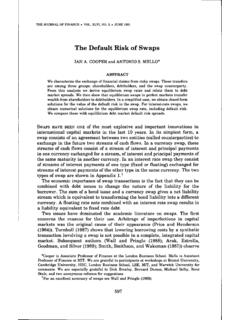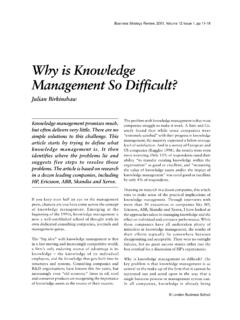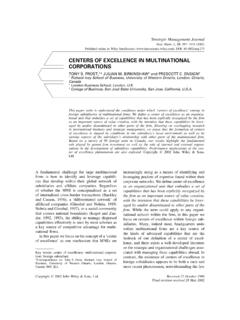Transcription of Optimal Versus Naive Diversification: How Inefficient is the ...
1 Optimal Versus Naive Diversification:How Inefficient is the 1/NPortfolio Strategy?Victor DeMiguelLondon Business SchoolLorenzo GarlappiUniversity of Texas at AustinRaman UppalLondon Business School and CEPRWe evaluate the out-of-sample performance of the sample-based mean-variance model, andits extensions designed to reduce estimation error, relative to the Naive 1/Nportfolio. Of the14 models we evaluate across seven empirical datasets, none is consistently better than the1/Nrule in terms of Sharpe ratio, certainty-equivalent return, or turnover, which indicatesthat, out of sample, the gain from Optimal diversification is more than offset by estimationerror. Based on parameters calibrated to the US equity market, our analytical results andsimulations show that the estimation window needed for the sample-based mean-variancestrategy and its extensions to outperform the 1/Nbenchmark is around 3000 months for aportfolio with 25 assets and about 6000 months for a portfolio with 50 assets.
2 This suggeststhat there are still many miles to go before the gains promised by Optimal portfolio choicecan actually be realized out of sample. (JELG11)In about the fourth century, Rabbi Issac bar Aha proposed the following rulefor asset allocation: One should always divide his wealth into three parts: athird in land, a third in merchandise, and a third ready to hand. 1 After a brief We wish to thank Matt Spiegel (the editor), two anonymous referees, and Lubo sP astor for extensive comments;John Campbell and Luis Viceira for their suggestions and for making available their data and computer code;and Roberto Wessels for making available data on the ten sector portfolios of the S&P 500 index . We alsogratefully acknowledge the comments from Pierluigi Balduzzi, John Birge, Michael Brennan, Ian Cooper,Bernard Dumas, Bruno Gerard, Francisco Gomes, Eric Jacquier, Chris Malloy, Francisco Nogales, Anna Pavlova,Loriana Pelizzon, Nizar Touzi, Sheridan Titman, Rossen Valkanov, Yihong Xia, Tan Wang, Zhenyu Wang,and seminar participants at BI Norwegian School of Management, HEC Lausanne, HEC Montr eal, LondonBusiness School, Manchester Business School, Stockholm School of Economics, University of Mannheim,University of Texas at Austin, University of Venice, University of Vienna, the Second McGill Conference onGlobal Asset Management, the 2004 International Symposium on Asset Allocation and Pension Managementat Copenhagen Business School, the 2005 Conference on Developments in Quantitative Finance at the IsaacNewton Institute for Mathematical Sciences at Cambridge University, the 2005 Workshop on Optimizationin Finance at University of Coimbra.
3 The 2005 meeting of the Western Finance Association, the 2005 annualmeeting of INFORMS, the 2005 conference of the Institute for Quantitative Investment Research (InquireUK), the 2006 NBER Summer Institute, the 2006 meeting of the European Finance Association, and the FirstAnnual Meeting of the Swiss Finance Institute. Send correspondence to Lorenzo Garlappi, McCombs Schoolof Business, University of Texas at Austin, Austin, TX 78712; telephone: (512) 471-5682; fax: (512) : Talmud: Tractate Baba Mezi a, folio The Author 2007. Published by Oxford University Press on behalf of The Society for Financial rights reserved. For Permissions, please e-mail: Access publication December 3, 2007 The Review of Financial Studies / v 22 n 5 2009lull in the literature on asset allocation, there have been considerable advancesstarting with the pathbreaking work of Markowitz (1952),2who derived theoptimalrule for allocating wealth across risky assets in a static setting wheninvestors care only about the mean and variance of a portfolio s return.
4 Be-cause the implementation of these portfolios with moments estimated via theirsample analogues is notorious for producing extreme weights that fluctuatesubstantially over time and perform poorly out of sample, considerable efforthas been devoted to the issue of handling estimation error with the goal ofimproving the performance of the Markowitz prominent role in this vast literature is played by theBayesian approachto estimation error, with its multiple implementations ranging from the purelystatistical approach relying on diffuse-priors (Barry, 1974; Bawa, Brown, andKlein, 1979), to shrinkage estimators (Jobson, Korkie, and Ratti, 1979;Jobson and Korkie, 1980; Jorion, 1985, 1986), to the more recent approachesthat rely on an asset-pricing model for establishing a prior (P astor, 2000; P astorand Stambaugh, 2000).4 Equally rich is the set ofnon-Bayesianapproaches toestimation error, which include robust portfolio allocation rules (Goldfarband Iyengar, 2003; Garlappi, Uppal, and Wang, 2007); portfolio rules designedto optimally diversify across marketandestimation risk (Kan and Zhou, 2007);portfolios that exploit the moment restrictions imposed by the factor struc-ture of returns (MacKinlay and Pastor, 2000); methods that focus on reducingthe error in estimating the covariance matrix (Best and Grauer, 1992; Chan,Karceski, and Lakonishok, 1999; Ledoit and Wolf, 2004a, 2004b); and, finally,portfolio rules that impose shortselling constraints (Frost and Savarino, 1988;Chopra, 1993; Jagannathan and Ma, 2003).
5 5 Our objective in this paper is to understand the conditions under whichmean-variance Optimal portfolio models can be expected to perform well evenin the presence of estimation risk. To do this, we evaluate theout-of-sampleperformance of the sample-based mean-variance portfolio rule and its variousextensions designed to reduce the effect of estimation error relative to theperformance of thenaiveportfolio diversification rule. We define the naiverule to be one in which a fraction 1/Nof wealth is allocated to each of theNassets available for investment at each rebalancing date. There are two reasonsfor using the Naive rule as a benchmark. First, it is easy to implement becauseit does not rely either on estimation of the moments of asset returns or on2 Some of the results on mean-variance portfolio choice in Markowitz (1952, 1956, 1959) and Roy (1952) hadalready been anticipated in 1940 by de Finetti, an English translation of which is now available in Barone (2006).
6 3 For a discussion of the problems in implementing mean-variance Optimal portfolios, see Hodges and Brealey(1978), Michaud (1989), Best and Grauer (1991), and Litterman (2003). For a general survey of the literature onportfolio selection, see Campbell and Viceira (2002) and Brandt (2007).4 Another approach, proposed by Black and Litterman (1990, 1992), combines two sets of priors one based onan equilibrium asset-pricing model and the other on the subjective views of the investor which is not strictlyBayesian, because a Bayesian approach combines a prior with the (1998) has advocated the use of resampling methods; Scherer (2002) and Harvey et al. (2003) discussthe various limitations of this Versus Naive DiversificationTable 1 List of various asset-allocation models considered#ModelAbbreviationNaive0. 1/Nwith rebalancing(benchmark strategy)ew or 1/NClassical approach that ignores estimation error1. Sample-based mean-variancemvBayesian approach to estimation error2.
7 Bayesian diffuse-priorNot reported3. Bayes-Steinbs4. Bayesian Data-and-ModeldmMoment restrictions5. Minimum-variancemin6. Value-weighted market portfoliovw7. MacKinlay and Pastor s (2000) missing-factor modelmpPortfolio constraints8. Sample-based mean-variance with shortsale constraintsmv-c9. Bayes-Stein with shortsale constraintsbs-c10. Minimum-variance with shortsale constraintsmin-c11. Minimum-variance with generalized constraintsg-min-cOptimal combinations of portfolios12. Kan and Zhou s (2007) three-fund modelmv-min13. Mixture of minimum-variance and 1/New-min14. Garlappi, Uppal, and Wang s (2007) multi-prior modelNot reportedThis table lists the various asset-allocation models we consider. The last column of thetable gives the abbreviation used to refer to the strategy in the tables where we compare theperformance of the Optimal portfolio strategies to that of the 1/Nstrategy. The results fortwo strategies are not reported.
8 The reason for not reporting the results for the Bayesiandiffuse-prior strategy is that for an estimation period that is of the length that we areconsidering (60 or 120 months), the Bayesian diffuse-prior portfolio is very similar tothe sample-based mean-variance portfolio. The reason for not reporting the results for themulti-prior robust portfolio described in Garlappi, Uppal, and Wang (2007) is that theyshow that the Optimal robust portfolio is a weighted average of the mean-variance andminimum-variance portfolios, the results for both of which are already being Second, despite the sophisticated theoretical models developedin the last 50 years and the advances in methods for estimating the parametersof these models, investors continue to use such simple allocation rules forallocating their wealth across wish to emphasize, however, thatthe purpose of this study isnotto advocate the use of the 1/Nheuristic asan asset-allocation strategy, but merely to use it as a benchmark to assess theperformance of various portfolio rules proposed in the compare the out-of-sample performance of 14 different portfolio modelsrelative to that of the 1/Npolicy across seven empirical datasets of monthlyreturns, using the following three performance criteria: (i) the out-of-sampleSharpe ratio.
9 (ii) the certainty-equivalent (CEQ) return for the expected utilityof a mean-variance investor; and (iii) the turnover (trading volume) for eachportfolio strategy. The 14 models are listed in Table 1 and discussed in Section seven empirical datasets are listed in Table 2 and described in Appendix instance, Benartzi and Thaler (2001) document that investors allocate their wealth across assets using thenaive 1/Nrule. Huberman and Jiang (2006) find that participants tend to invest in only a small number of thefunds offered to them, and that they tend to allocate their contributions evenly across the funds that they use,with this tendency weakening with the number of funds Review of Financial Studies / v 22 n 5 2009 Table 2 List of datasets considered#Dataset and sourceNTime periodAbbreviation1 Ten sector portfolios of the S&P 500 and10+101/1981 12/2002 S&P Sectorsthe US equity market portfolioSource: Roberto Wessels2 Ten industry portfolios and10+107/1963 11/2004 Industrythe US equity market portfolioSource: Ken French s Web site3 Eight country indexes and8+101/1970 07/2001 Internationalthe world IndexSource: MSCI4 SMB and HML portfolios and2+107/1963 11/2004 MKT/SMB/HMLthe US equity market portfolioSource: Ken French s Web site5 Twenty size- and book-to-market portfolios and20+107/1963 11/2004 FF-1-factorthe US equity MKTS ource.
10 Ken French s Web site6 Twenty size- and book-to-market portfolios and20+307/1963 11/2004 FF-3-factorthe MKT, SMB, and HML portfoliosSource: Ken French s Web site7 Twenty size- and book-to-market portfolios and20+407/1963 11/2004 FF-4-factorthe MKT, SMB, HML, and UMD portfoliosSource: Ken French s Web site8 Simulated data{10,25,50}2000 years Source: Market modelThis table lists the various datasets analyzed; the number of risky assetsNin each dataset, where the numberafter the + indicates the number of factor portfolios available; and the time period spanned. Each datasetcontains monthly excess returns over the 90-day nominal US T-bill (from Ken French s Web site). In the lastcolumn is the abbreviation used to refer to the dataset in the tables evaluating the performance of the variousportfolio strategies. Note that as in Wang (2005), of the 25 size- and book-to-market-sorted portfolios, weexclude the five portfolios containing the largest firms, because the market, SMB, and HML are almost a linearcombination of the 25 Fama-French portfolios.





